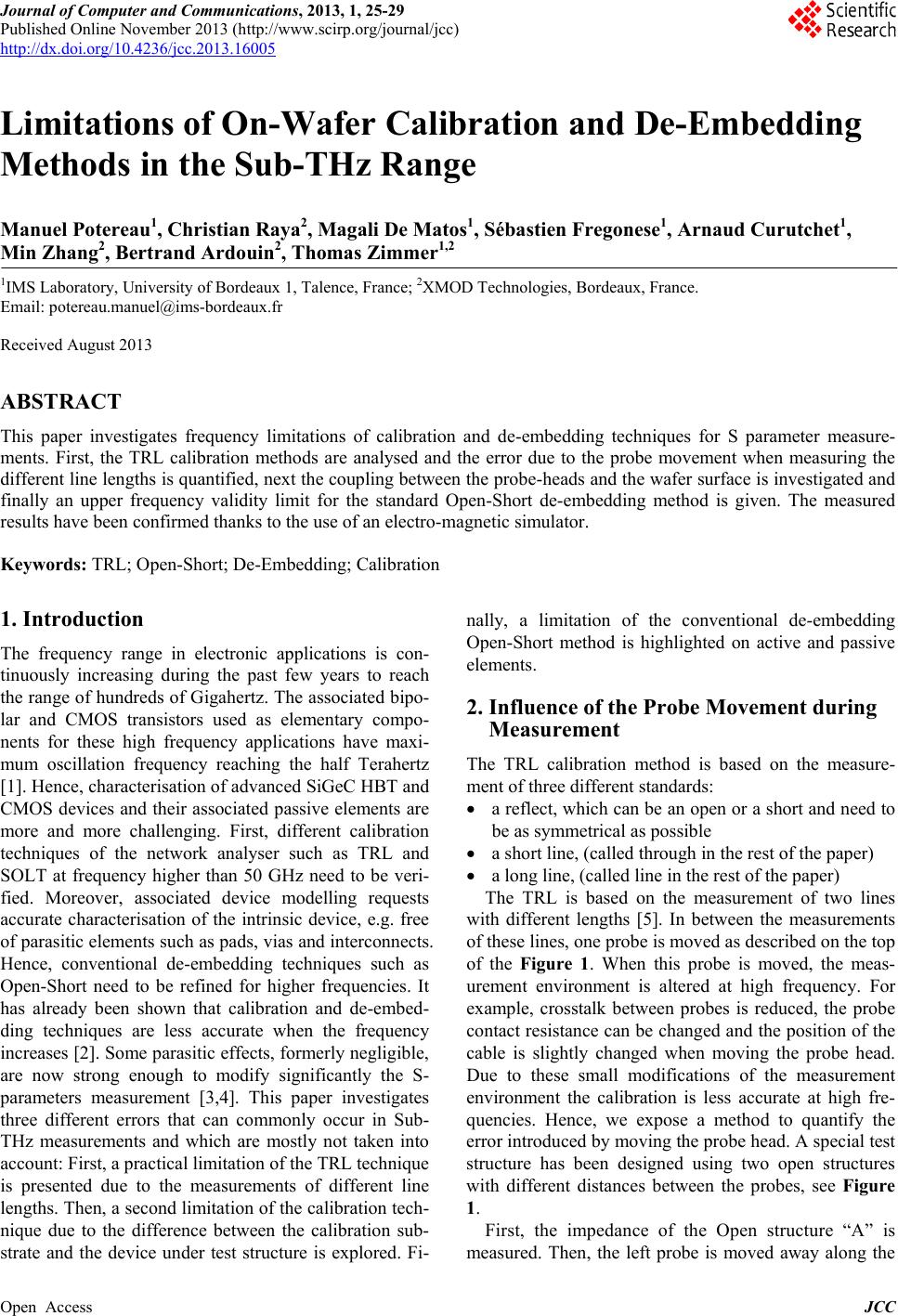
Journal of Computer and Communications, 2013, 1, 25-29
Published Online November 2013 (http://www.scirp.org/journal/jcc)
http://dx.doi.org/10.4236/jcc.2013.16005
Open Access JCC
Limitations of On-Wafer Calibration and De-Embedding
Methods in the Sub-THz Range
Manuel Poterea u 1, Christian Raya2, Magali De Matos1, Sébastien Fregonese1, Arnaud Curutchet1,
Min Zhang2, Bertrand Ardouin2, Thomas Zimmer1,2
1IMS Laboratory, University of Bordeaux 1, Talence, France; 2XMOD Technologies, Bordeaux, France.
Email: potereau.manuel@ims-bordeaux.fr
Received August 2013
ABSTRACT
This paper investigates frequency limitations of calibration and de-embedding techniques for S parameter measure-
ments. First, the TRL calibration methods are analysed and the error due to the probe movement when measuring the
different line lengths is quantified, next the coupling between the probe-heads and the wafer surface is investigated and
finally an upper frequency validity limit for the standard Open-Short de-embedding method is given. The measured
results have been confirmed thanks to the use of an electro-magnetic simulator.
Keywords: TRL; Open-Short; De-Embedding; Calibration
1. Introduction
The frequency range in electronic applications is con-
tinuously increasing during the past few years to reach
the range of hundreds of Gigahertz. The associated bipo-
lar and CMOS transistors used as elementary compo-
nents for these high frequency applications have maxi-
mum oscillation frequency reaching the half Terahertz
[1]. Hence, characterisation of advanced SiGeC HBT and
CMOS devices and their associated passive elements are
more and more challenging. First, different calibration
techniques of the network analyser such as TRL and
SOLT at frequency higher than 50 GHz need to be veri-
fied. Moreover, associated device modelling requests
accurate characterisation of the intrinsic device, e.g. free
of parasitic elements such as pads, vias and interconnects.
Hence, conventional de-embedding techniques such as
Open-Short need to be refined for higher frequencies. It
has already been shown that calibration and de-embed-
ding techniques are less accurate when the frequency
increases [2]. Some parasitic effects, formerly negligible,
are now strong enough to modify significantly the S-
parameters measurement [3,4]. This paper investigates
three different errors that can commonly occur in Sub-
THz measurements and which are mostly not taken into
account: First, a practical li mitation of the TRL technique
is presented due to the measurements of different line
lengths. Then, a second limitation of the calibra tion tech-
nique due to the difference between the calibration sub-
strate and the device under test structure is explored. Fi-
nally, a limitation of the conventional de-embedding
Open-Short method is highlighted on active and passive
elements.
2. Influence of the Probe Movement during
Measurement
The TRL calibration method is based on the measure-
ment of three different standards:
• a reflect, which can be an open or a short and need to
be as symmetrical as possible
• a short line, (called through in the rest of the paper)
• a long line, (called line in the rest of the paper)
The TRL is based on the measurement of two lines
with different lengths [5]. In between the measurements
of these lines, one probe is moved as described on the top
of the Figure 1. When this probe is moved, the meas-
urement environment is altered at high frequency. For
example, crosstalk between probes is reduced, the probe
contact resistance can be changed and the positio n of the
cable is slightly changed when moving the probe head.
Due to these small modifications of the measurement
environment the calibration is less accurate at high fre-
quencies. Hence, we expose a method to quantify the
error introduced by moving the probe he ad . A special test
structure has been designed using two open structures
with different distances between the probes, see Figure
1. First, the impedance of the Open structure “A” is
measured. Then, the left probe is moved away along the